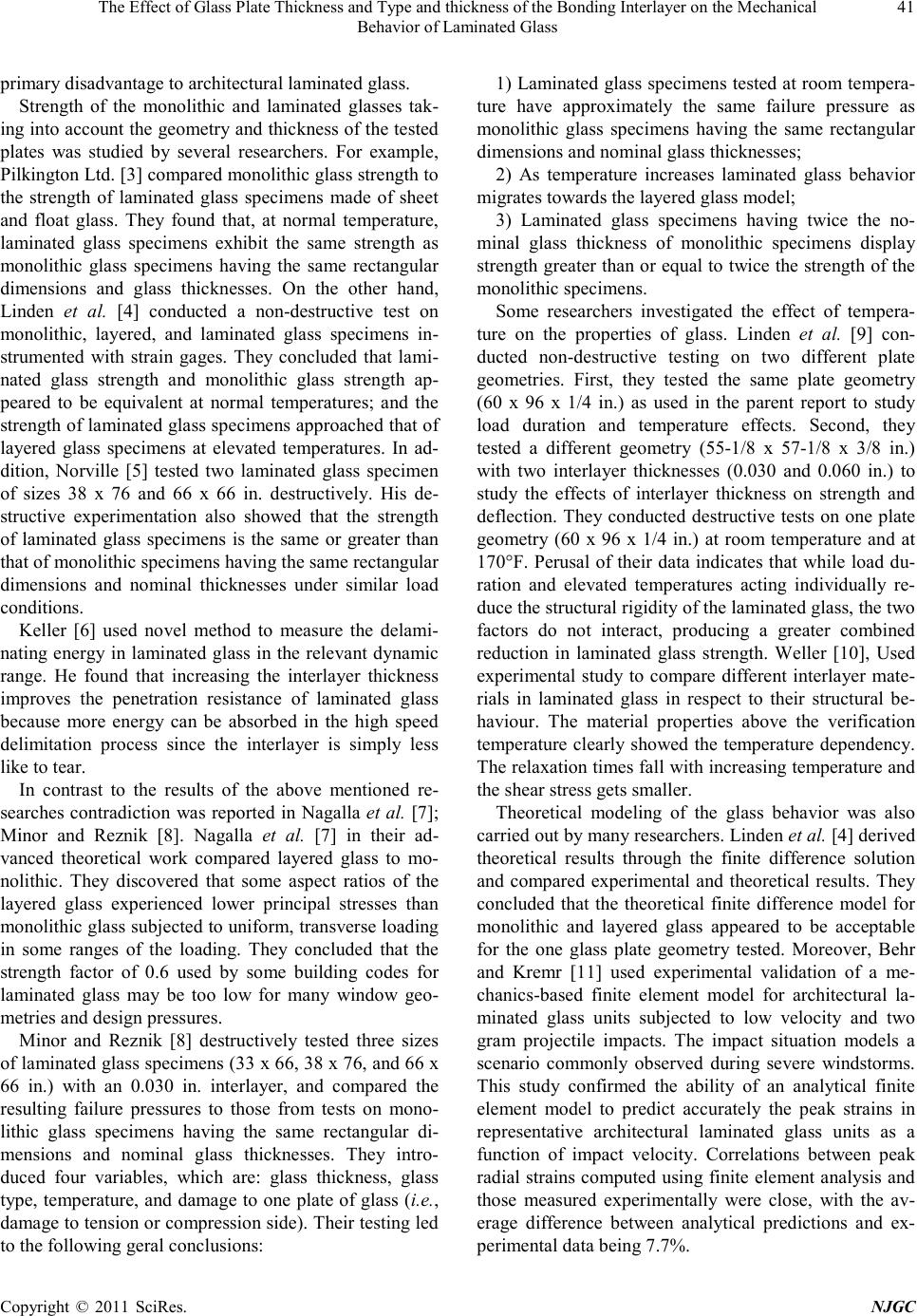
The Effect of Glass Plate Thickness and Type and thickness of the Bonding Interlayer on the Mechanical
Behavio r of Laminated Glass
Copyright © 2011 SciRes. NJGC
primary disadvantage to a r c hitectural laminated glas s.
Strength of the monolithic and laminated glasses tak-
ing in to ac count the geo metr y and thi ckne ss of t he te sted
plates was studied by several researchers. For example,
Pilkington Ltd. [ 3] co mpared monolit hic glas s stre ngth to
the strength of laminated glass specimens made of sheet
and float glass. They found that, at normal temperature,
laminated glass specimens exhibit the same strength as
monolithic glass specimens having the same rectangular
dimensions and glass thicknesses. On the other hand,
Linden et al. [4] conducted a non-destructive test on
monolithic, layered, and laminated glass specimens in-
strumented with strain gages. They concluded that lami-
nated glass strength and monolithic glass strength ap-
peared to be equivalent at normal temperatures; and the
strength of la minated gla ss specimens approached that of
layered glass specimens at elevated temperatures. In ad-
dition, Norville [5] tested two laminated glass specimen
of sizes 38 x 76 and 66 x 66 in. destructively. His de-
structive experimentation also showed that the strength
of laminated glass specimens is the same or greater than
that of monolithic specimens having the same rectangular
dimensions and nominal thicknesses under similar load
conditions.
Keller [6] used novel method to measure the delami-
nating energy in laminated glass in the rele vant dynamic
range. He found that increasing the interlayer thickness
improves the penetration resistance of laminated glass
because more energy can be absorbed in the high speed
delimitation process since the interlayer is simply less
like to tear.
In contrast to the results of the above mentioned re-
searches contradiction was reported in Nagalla et al. [7] ;
Minor and Reznik [8]. Nagalla et al. [7] in their ad-
vanced theoretical work compared layered glass to mo-
nolithic. They discovered that some aspect ratios of the
layered glass experienced lower principal stresses than
monolit hic glass subje cted to unifor m, transver se loading
in some ranges of the loading. They concluded that the
strength factor of 0.6 used by some building codes for
laminated glass may be too low for many window geo-
metries and design pressures.
Minor and Reznik [8] destructively tested three sizes
of laminated glass specimens (33 x 66, 38 x 76, and 66 x
66 in.) with an 0.030 in. interlayer, and compared the
resulting failure pressures to those from tests on mono-
lithic glass specimens having the same rectangular di-
mensions and nominal glass thicknesses. They intro-
duced four variables, which are: glass thickness, glass
type, temperature, and damage to one plate of glass (i.e.,
damage to tension or compression side) . Their te sting led
to the following geral conclusi ons:
1) Laminated glass specimens tested at room tempera-
ture have approximately the same failure pressure as
monolithic glass specimens having the same rectangular
dimensions and nominal glas s thicknesses;
2) As temperature increases laminated glass behavior
migrates towards the layered glass model;
3) Laminated glass specimens having twice the no-
minal glass thickness of monolithic specimens display
strength greater than or equa l to twice t he strengt h of the
monol ithi c specimens.
Some researchers investigated the effect of tempera-
ture on the properties of glass. Linden et al. [9] con-
ducted non-destructive testing on two different plate
geometries. First, they tested the same plate geometry
(60 x 96 x 1/4 in.) as used in the parent report to study
load duration and temperature effects. Second, they
tested a different geometry (55-1/8 x 57-1/8 x 3/8 in.)
with two interlayer thicknesses (0.030 and 0.060 in.) to
study the effects of interlayer thickness on strength and
deflection. They conducted destructive tests on one plate
geometry (60 x 96 x 1/4 in.) at room temperature and at
170°F. Perusal of their data indicates that while load du-
ration and elevated temperatures acting individually re-
duce the s tr uctural rigidity of the laminated glass, the two
factors do not interact, producing a greater combined
reduction in laminated glass strength. Weller [10], Used
experimental study to compare different interlayer mate-
rials in laminated glass in respect to their structural be-
haviour. The material properties above the verification
temperature clearly showed the temperature dependency.
The relaxation times fall with increasing temperature and
the shear stress gets smaller.
Theoretical modeling of the glass behavior was also
carried out by many researchers. Linden et al. [4 ] derived
theoretical results through the finite difference solution
and compared experimental and theoretical results. They
concluded that the theoretical finite difference model for
monolithic and layered glass appeared to be acceptable
for the one glass plate geometry tested. Moreover, Behr
and Kremr [11] used experimental validation of a me-
chanics-based finite element model for architectural la-
minated glass units subjected to low velocity and two
gram projectile impacts. The impact situation models a
scenario commonly observed during severe windstorms.
This study confirmed the ability of an analytical finite
element model to predict accurately the peak strains in
representative architectural laminated glass units as a
function of impact velocity. Correlations between peak
radial strains computed using finite element analysis and
those measured experimentally were close, with the av-
erage difference between analytical predictions and ex-
perimental data being 7.7%.